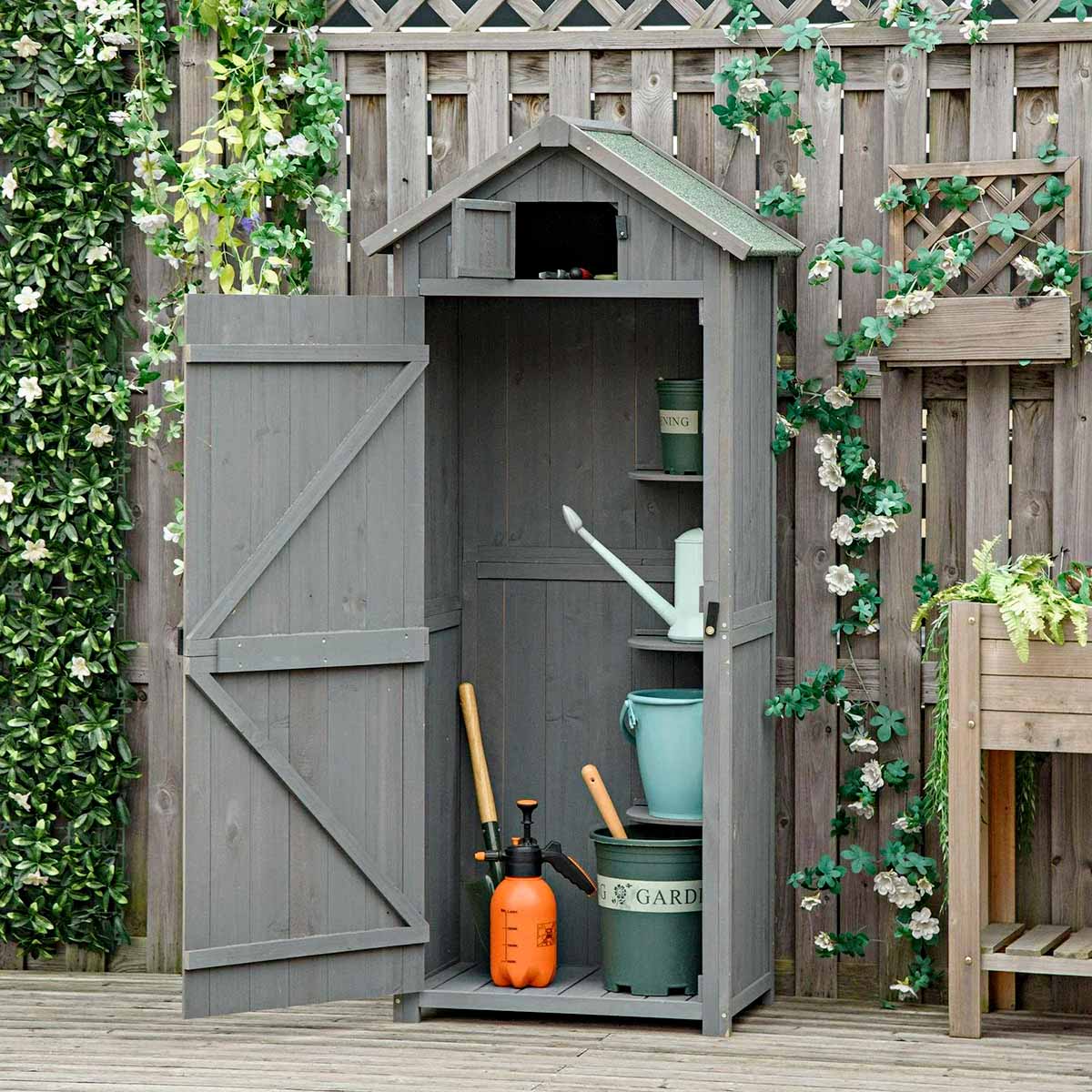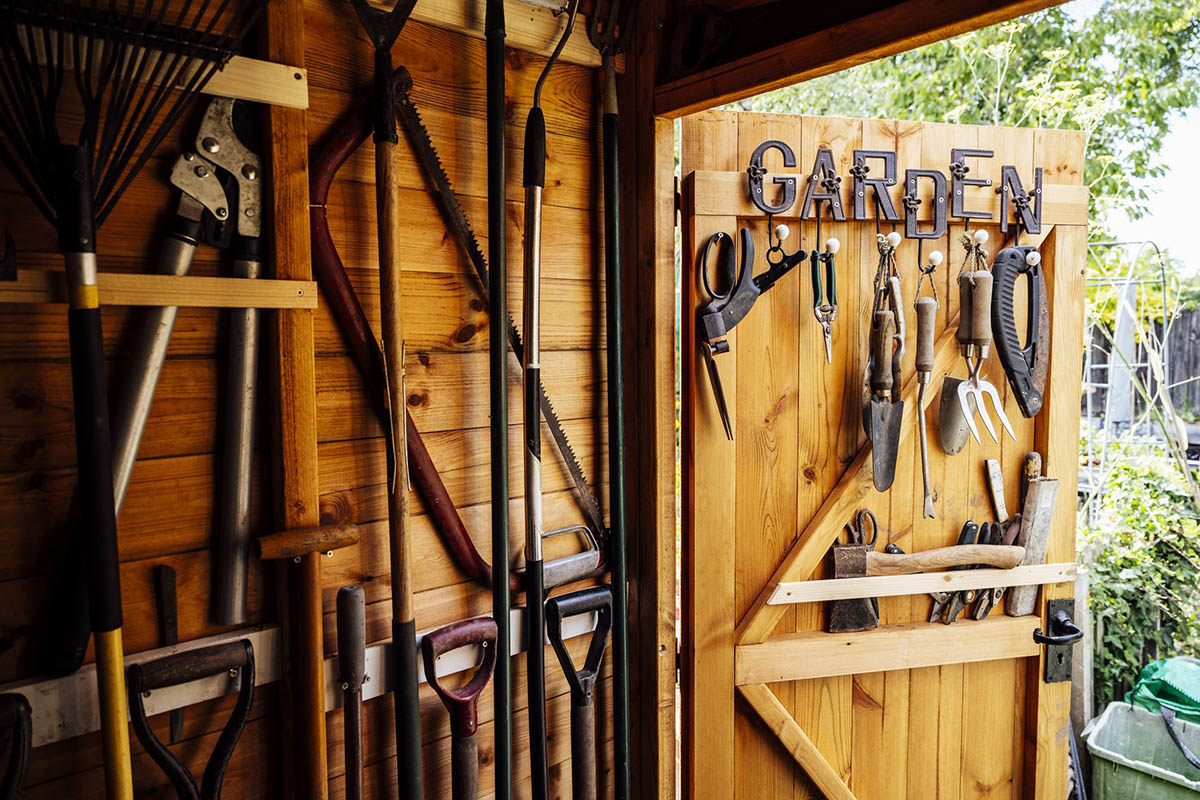Home>Gardening & Outdoor>Outdoor Structures>How To Organize A Tool Shed


Outdoor Structures
How To Organize A Tool Shed
Modified: August 20, 2024
Learn how to efficiently organize your outdoor structures with our expert tips and tricks. Maximize space and keep your tool shed tidy and functional.
(Many of the links in this article redirect to a specific reviewed product. Your purchase of these products through affiliate links helps to generate commission for Storables.com, at no extra cost. Learn more)
**
Introduction
**
Organizing a tool shed may seem like a daunting task, but with the right approach and a bit of creativity, it can be a rewarding and satisfying endeavor. A well-organized tool shed not only makes it easier to find and access your tools but also helps to prolong their lifespan by keeping them in good condition. Whether you're an avid gardener, a DIY enthusiast, or a professional tradesperson, a well-organized tool shed can save you time and frustration, allowing you to focus on the task at hand rather than searching for misplaced tools.
In this comprehensive guide, we'll explore the essential steps to effectively organize your tool shed. From assessing your tools and designing the layout to sorting and categorizing, we'll cover everything you need to know to transform your cluttered shed into a well-ordered and functional space. Additionally, we'll delve into storage solutions and maintenance tips to ensure that your tools remain in top condition and easily accessible whenever you need them.
So, roll up your sleeves, gather your enthusiasm, and let's dive into the art of organizing a tool shed. With the right approach and a touch of creativity, you'll soon have a well-organized space that not only showcases your tools but also makes your work more efficient and enjoyable.
Key Takeaways:
- Assess your tools by categorizing, checking quality, and noting frequency of use. This sets the foundation for a well-organized shed that enhances efficiency and safety.
- Design the layout, sort and categorize tools, and implement storage solutions to create an efficient and visually appealing workspace. Regular maintenance ensures tools remain in top condition.
Read more: How To Dismantle A Tool Shed
Assessing Your Tools
Before embarking on the task of organizing your tool shed, it’s crucial to assess the tools you have. Start by taking inventory of all your tools, including hand tools, power tools, gardening implements, and any other equipment stored in the shed. As you assess your tools, consider their frequency of use, size, and the specific tasks for which they are utilized.
Categorization: Begin by categorizing your tools based on their functionality. Separate gardening tools from carpentry tools, electrical tools from plumbing tools, and so on. This initial categorization will provide a clear overview of the types of tools you have and help determine the most efficient way to organize them.
Quality and Condition: As you assess your tools, pay attention to their quality and condition. Discard or repair any damaged or rusted tools, as they not only take up valuable space but can also pose safety hazards. Consider donating or recycling tools that are in good condition but are no longer needed.
Frequency of Use: Take note of the tools you use most frequently and those that are seldom used. This will help prioritize the accessibility and storage of your tools. Frequently used tools should be easily reachable, while infrequently used tools can be stored in less accessible areas of the shed.
Storage Requirements: Consider the storage requirements of each tool. Some tools may need specific storage conditions to prevent damage, such as keeping them dry or protecting them from extreme temperatures. Take these requirements into account when planning the layout and storage solutions for your tool shed.
By thoroughly assessing your tools, you’ll gain valuable insights that will inform the organization and layout of your tool shed. This initial step sets the foundation for creating a well-organized space that not only showcases your tools but also enhances your efficiency and productivity.
Designing the Layout
Once you’ve assessed your tools, it’s time to design the layout of your tool shed. The layout should prioritize accessibility, safety, and efficient use of space. Consider the following factors when designing the layout:
Accessibility: Arrange your tools in a way that makes them easily accessible. Frequently used tools should be within arm’s reach, while less frequently used items can be stored in higher or lower spaces. Consider installing wall-mounted racks, pegboards, or shelving units to maximize vertical storage and keep tools off the floor, reducing the risk of accidents and making the most of the available space.
Workstation Area: If your tool shed serves as a workspace for DIY projects or gardening, designate a specific area for workbenches or tables. Ensure that this area is well-lit and equipped with power outlets if you frequently use power tools. Organize the tools and supplies used for specific tasks near their respective workstations to streamline your workflow.
Traffic Flow: Plan the layout to allow for easy movement within the shed. Avoid cluttering walkways and doorways with tools or storage units. Keep frequently used tools near the entrance for quick access, and arrange larger equipment or storage units along the walls to free up the central space.
Safety Considerations: Prioritize safety when designing the layout. Store sharp tools and hazardous materials out of reach of children and pets. Ensure that heavy items are stored securely to prevent them from toppling over. Additionally, consider installing adequate lighting and ventilation to create a safe and comfortable working environment.
Future Expansion: Anticipate future tool acquisitions and plan the layout with flexibility in mind. Leave room for additional storage solutions or new tools, and consider modular storage systems that can be easily reconfigured as your tool collection grows.
By carefully designing the layout of your tool shed, you can create an organized and efficient space that not only showcases your tools but also enhances your productivity and safety. The layout should reflect your workflow and the specific tasks you perform in the shed, resulting in a functional and inviting workspace.
Sorting and Categorizing
Sorting and categorizing your tools is a crucial step in the organization process, as it lays the groundwork for an efficient and systematic storage system. By grouping similar tools together and creating distinct categories, you can streamline the retrieval process and maintain a tidy and organized tool shed. Here’s how to approach sorting and categorizing your tools:
Grouping by Function: Begin by grouping your tools based on their primary functions. For instance, separate gardening tools from woodworking tools, electrical equipment from plumbing supplies, and so on. This initial categorization provides a clear overview of the types of tools you have and informs the subsequent steps in the organization process.
Sub-Categorization: Within each primary category, further sub-categorize your tools based on their specific uses. For example, within the gardening tools category, create sub-categories for hand tools, power tools, and landscaping equipment. This level of detail will make it easier to locate specific tools when needed.
Labeling and Identification: Once you’ve sorted your tools into categories and sub-categories, consider labeling storage containers, shelves, and drawers to indicate the contents of each. Clear and visible labels facilitate quick identification and ensure that tools are returned to their designated spots after use, maintaining the organization of the shed.
Storage Allocation: Allocate specific storage areas for each category of tools based on their frequency of use and spatial requirements. Frequently used tools should be readily accessible, while infrequently used items can be stored in less accessible areas. Utilize storage solutions such as tool chests, wall-mounted racks, and stackable bins to keep each category of tools organized and easily retrievable.
Maintenance Supplies: In addition to tools, consider sorting and categorizing maintenance supplies such as lubricants, cleaning agents, and spare parts. Designate a separate area for these items, ensuring that they are easily accessible when needed for tool maintenance and repairs.
By systematically sorting and categorizing your tools, you can establish a well-organized system that maximizes efficiency and minimizes the time spent searching for specific items. This approach not only enhances the functionality of your tool shed but also contributes to a visually appealing and inviting workspace.
Use pegboards and hooks to hang tools for easy access and to save space. Group similar items together and label shelves or containers for quick identification.
Storage Solutions
Effective storage solutions are essential for maintaining a well-organized tool shed. By utilizing suitable storage systems, you can optimize space, enhance accessibility, and ensure that your tools remain in good condition. Consider the following storage solutions to create an efficient and visually appealing storage environment:
Wall-Mounted Racks and Pegboards: Install wall-mounted racks and pegboards to store frequently used hand tools such as hammers, wrenches, and screwdrivers. These systems not only keep tools within easy reach but also free up valuable workspace and prevent clutter on benches and tables.
Shelving Units: Utilize sturdy shelving units to store larger tools, power equipment, and storage containers. Adjustable shelves allow you to customize the storage space based on the size and quantity of items, while clear plastic bins or labeled storage boxes help keep smaller items organized and easily identifiable.
Overhead Storage: Maximize vertical space by installing overhead storage solutions, such as ceiling-mounted racks or pulley systems. These are ideal for storing bulky or seasonal items, including ladders, long-handled tools, and outdoor gear, freeing up floor and wall space for frequently used tools and equipment.
Tool Cabinets and Chests: Invest in tool cabinets or chests with drawers and compartments to store and organize a wide range of tools. These provide secure storage for hand tools, power tools, and accessories, with the added benefit of keeping your tools protected from dust, moisture, and damage.
Modular Storage Systems: Consider modular storage systems that offer flexibility and adaptability as your tool collection evolves. These systems often feature interchangeable components, allowing you to customize the storage layout to accommodate new tools and equipment as needed.
Outdoor Storage Solutions: If your tool shed also serves as a storage space for outdoor equipment or gardening supplies, consider incorporating outdoor storage solutions such as weather-resistant cabinets, bins, or lockable containers. These are ideal for safeguarding items from the elements while keeping them easily accessible.
By implementing a combination of these storage solutions, you can create a well-organized and efficient storage environment within your tool shed. The strategic placement of tools and equipment not only enhances accessibility but also contributes to a visually appealing and functional workspace, making your tasks more enjoyable and productive.
Read more: How To Connect Power To A Tool Shed
Maintenance Tips
Maintaining your tools and the overall organization of your tool shed is essential for ensuring their longevity and optimal performance. By incorporating regular maintenance practices into your routine, you can prolong the lifespan of your tools and sustain a well-organized workspace. Consider the following maintenance tips to uphold the functionality and appearance of your tools and tool shed:
Cleaning and Lubrication: Regularly clean your tools to remove dirt, debris, and corrosive substances that may compromise their functionality. Use appropriate cleaning agents and brushes to remove residue, followed by lubrication of moving parts to prevent rust and ensure smooth operation. Additionally, wipe down surfaces and shelves in the tool shed to maintain a clean and tidy environment.
Inspecting and Repairing: Routinely inspect your tools for signs of wear, damage, or malfunction. Address any issues promptly by repairing or replacing damaged components. This proactive approach not only extends the lifespan of your tools but also reduces the risk of accidents and injuries resulting from faulty equipment.
Sharpening and Calibration: Sharpen bladed tools such as axes, chisels, and pruners to maintain their cutting effectiveness. Similarly, calibrate measuring and cutting tools to ensure accuracy and precision in your work. Properly maintained tools not only produce better results but also contribute to a safer and more efficient working environment.
Seasonal Maintenance: Consider seasonal maintenance tasks tailored to the specific tools and equipment stored in your shed. For instance, winterize power equipment before storing it for the season, protect wooden handles from excessive moisture, and inspect garden hoses and watering systems for leaks or damage before the gardening season begins.
Organizational Maintenance: Regularly review and reorganize the layout and storage of your tools based on changes in your collection or workflow. Periodically assess the effectiveness of your organization system and make adjustments as needed to accommodate new tools or optimize accessibility.
Environmental Considerations: Take environmental factors into account when maintaining your tools and tool shed. Store tools away from direct sunlight to prevent fading or deterioration of materials, and address any issues related to moisture, humidity, or temperature fluctuations that may affect the condition of your tools and equipment.
By incorporating these maintenance tips into your regular routine, you can uphold the functionality, safety, and visual appeal of your tools and tool shed. Consistent maintenance not only preserves the quality of your tools but also contributes to a well-maintained and inviting workspace, enhancing your overall experience and productivity.
Conclusion
Organizing a tool shed is a transformative process that goes beyond tidying up a space; it’s about creating an environment that enhances your efficiency, safety, and enjoyment of your hobbies or professional tasks. By following the essential steps outlined in this guide, you can elevate your tool shed from a cluttered storage space to a well-organized and functional workshop. Assessing your tools, designing the layout, sorting and categorizing, implementing storage solutions, and maintaining your tools are integral components of this process.
Through the meticulous assessment of your tools, you gain valuable insights into their functionality, condition, and storage requirements. This knowledge serves as the foundation for designing a layout that prioritizes accessibility, safety, and future expansion. Sorting and categorizing your tools not only streamlines the retrieval process but also contributes to a visually appealing and inviting workspace.
Implementing effective storage solutions optimizes space and ensures that your tools remain organized and easily accessible. Additionally, incorporating regular maintenance practices into your routine sustains the longevity and performance of your tools and the overall organization of your tool shed. These maintenance efforts uphold the functionality, safety, and visual appeal of your tools and workspace, contributing to an enjoyable and productive environment.
By embracing the art of organizing a tool shed, you create a space that reflects your passion for craftsmanship, DIY projects, gardening, or professional trades. A well-organized tool shed not only showcases your tools but also provides a conducive environment for honing your skills and pursuing your interests. As you embark on this journey, remember that organization is a dynamic process, and periodic reassessment and adjustments will ensure that your tool shed continues to meet your evolving needs.
So, roll up your sleeves, apply the insights from this guide, and embark on the transformation of your tool shed. With dedication and a touch of creativity, you’ll soon revel in the functionality and visual appeal of your well-organized and inviting workspace.
Now that your tool shed's in tip-top shape, why stop there? Dive deeper into organization with our upcoming articles. If finding the perfect system for your tools sparks interest, don't miss our insights on top picks for tool storage, detailing the best options to keep everything within arm's reach next year. For those who need broader strategies, our ingenious methods for shed organization guide offers ten smart ways to maintain any shed's order long-term. Both pieces are packed with practical advice, ensuring your spaces aren't just tidy but smartly arranged.
Frequently Asked Questions about How To Organize A Tool Shed
Was this page helpful?
At Storables.com, we guarantee accurate and reliable information. Our content, validated by Expert Board Contributors, is crafted following stringent Editorial Policies. We're committed to providing you with well-researched, expert-backed insights for all your informational needs.















0 thoughts on “How To Organize A Tool Shed”